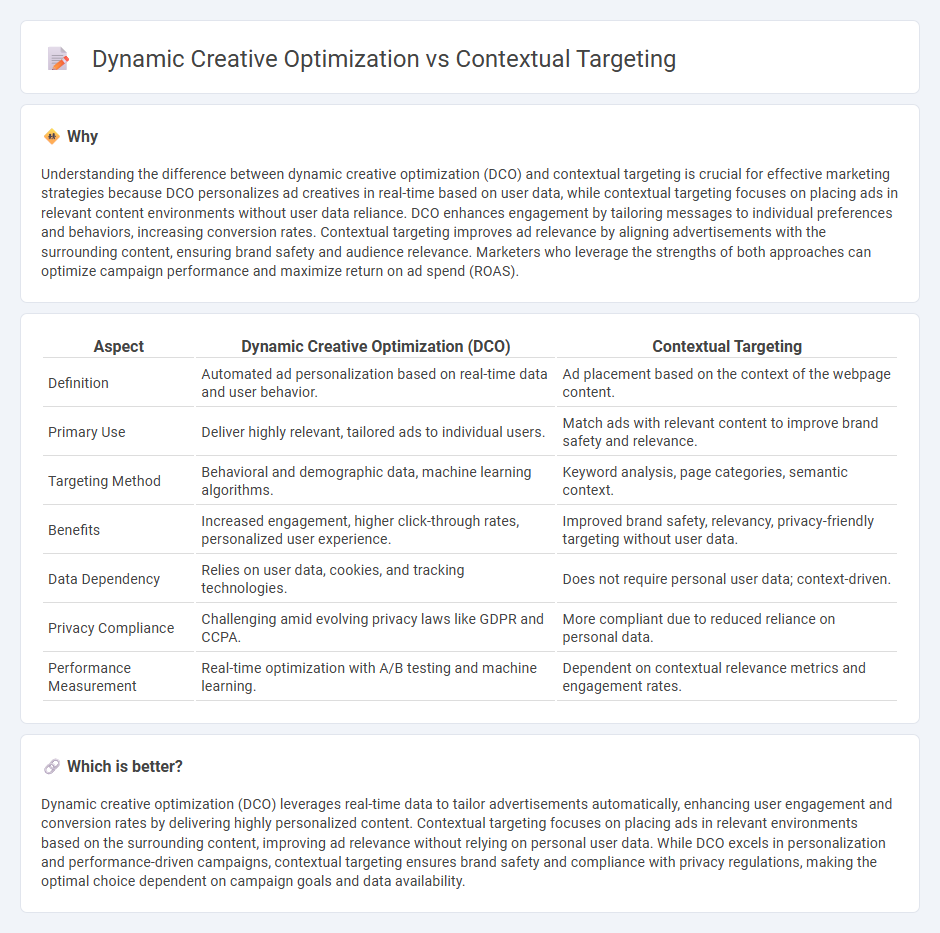
Dynamic creative optimization tailors advertising content in real-time based on user behavior, increasing relevance and engagement. Contextual targeting places ads according to the surrounding content, ensuring alignment with users' immediate interests. Explore the benefits and applications of each strategy to enhance your marketing campaigns.
Why it is important
Understanding the difference between dynamic creative optimization (DCO) and contextual targeting is crucial for effective marketing strategies because DCO personalizes ad creatives in real-time based on user data, while contextual targeting focuses on placing ads in relevant content environments without user data reliance. DCO enhances engagement by tailoring messages to individual preferences and behaviors, increasing conversion rates. Contextual targeting improves ad relevance by aligning advertisements with the surrounding content, ensuring brand safety and audience relevance. Marketers who leverage the strengths of both approaches can optimize campaign performance and maximize return on ad spend (ROAS).
Comparison Table
| Aspect | Dynamic Creative Optimization (DCO) | Contextual Targeting |
|---|---|---|
| Definition | Automated ad personalization based on real-time data and user behavior. | Ad placement based on the context of the webpage content. |
| Primary Use | Deliver highly relevant, tailored ads to individual users. | Match ads with relevant content to improve brand safety and relevance. |
| Targeting Method | Behavioral and demographic data, machine learning algorithms. | Keyword analysis, page categories, semantic context. |
| Benefits | Increased engagement, higher click-through rates, personalized user experience. | Improved brand safety, relevancy, privacy-friendly targeting without user data. |
| Data Dependency | Relies on user data, cookies, and tracking technologies. | Does not require personal user data; context-driven. |
| Privacy Compliance | Challenging amid evolving privacy laws like GDPR and CCPA. | More compliant due to reduced reliance on personal data. |
| Performance Measurement | Real-time optimization with A/B testing and machine learning. | Dependent on contextual relevance metrics and engagement rates. |
Which is better?
Dynamic creative optimization (DCO) leverages real-time data to tailor advertisements automatically, enhancing user engagement and conversion rates by delivering highly personalized content. Contextual targeting focuses on placing ads in relevant environments based on the surrounding content, improving ad relevance without relying on personal user data. While DCO excels in personalization and performance-driven campaigns, contextual targeting ensures brand safety and compliance with privacy regulations, making the optimal choice dependent on campaign goals and data availability.
Connection
Dynamic creative optimization (DCO) leverages real-time data to automatically tailor ad creatives to individual user preferences and behaviors, enhancing ad relevance. Contextual targeting complements DCO by placing these personalized ads within environments that match the user's immediate content context, increasing engagement and conversion rates. Together, DCO and contextual targeting maximize advertising efficiency by delivering hyper-relevant messages aligned with consumer intent and situational context.
Key Terms
Relevance
Contextual targeting enhances ad relevance by displaying ads aligned with the content of a webpage, ensuring the audience sees messages pertinent to their current interests. Dynamic creative optimization (DCO) improves relevance through real-time personalized ad variations based on user data, increasing engagement by tailoring visuals and messages to individual preferences. Explore how combining these strategies maximizes relevance and boosts ad performance.
Personalization
Contextual targeting delivers ads based on the content of the webpage, ensuring relevance without relying on user data, which enhances user privacy while matching ad themes to current interests. Dynamic Creative Optimization (DCO) uses real-time data and machine learning to personalize ad creatives for each individual, optimizing engagement by adjusting elements like images, text, and calls to action. Discover how these advanced methods personalize marketing strategies by exploring their unique benefits and applications.
Automation
Contextual targeting leverages automated algorithms to match ads with relevant content based on keywords and user intent, enhancing precision without manual intervention. Dynamic creative optimization (DCO) employs machine learning to automatically generate and test multiple ad variations, optimizing creatives in real-time for improved performance. Explore how automation transforms advertising strategies by blending contextual targeting and DCO.
Source and External Links
What is Contextual Advertising? Why is it Important? - Contextual targeting uses automated AI systems to analyze the current page content (text, images, media) and matches ads to relevant themes in real time, ensuring ads appear in suitable, high-quality environments without relying on past user data.
Contextual Advertising: What it is, how it works, and why to ... - Contextual targeting involves selecting targeting parameters such as keywords, topics, and languages to programmatically place ads on webpages with matching content, allowing precise or broad ad placements while also excluding unsuitable content via negative keywords or topics.
What is Contextual Targeting? - Advertisers use contextual targeting through DSPs by selecting segments based on industry, season, or topic to show ads in relevant environments using AI and NLP technologies, enabling cookie-free, privacy-safe campaigns that enhance ROI and avoid inappropriate placements.
 dowidth.com
dowidth.com